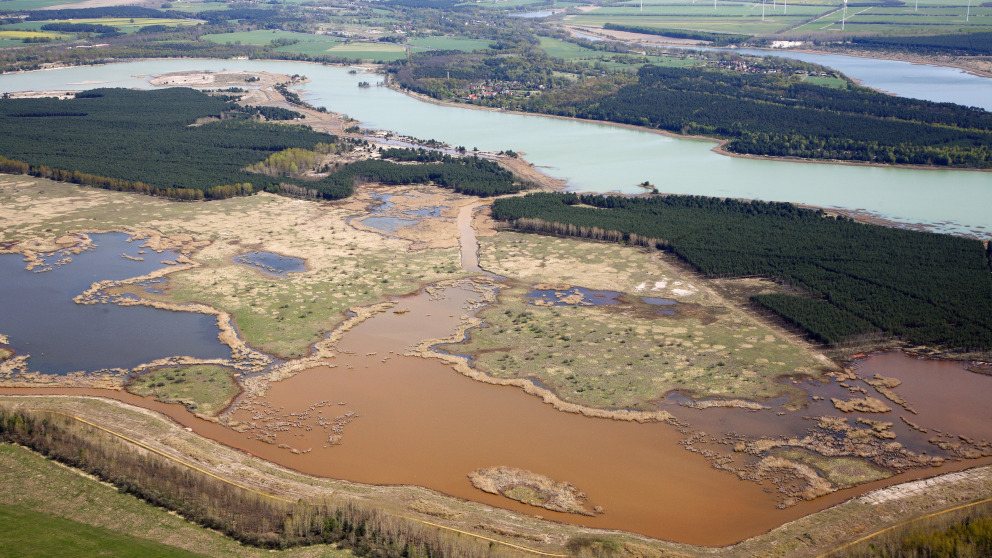Who is to Pay the Follow-Up Costs of Lignite-Mining? IASS Researcher Makes Policy Recommendations
14.11.2018
The days of Germany’s lignite-mining industry are numbered, that much is clear. The Coal Commission appointed by the Federal Government now has the job of planning how exactly the phaseout will proceed. One issue that is often overlooked in this context is the question of how the rehabilitation of former coal-mining sites is to be financed. A new IASS Discussion Paper examines the risks inherent in the existing financing practice and makes concrete proposals for changes.

Once they have ceased to operate, it will take many decades to rehabilitate opencast sites and repair the damages caused by mining activities. And it will cost billions of euros. Who is going to foot the bill? Under the Federal Mining Act, the polluter-pays principle applies in this case. That means that the mine operators are responsible for financing and carrying out the rehabilitation measures. The operators are supposed to set up provisions to ensure that they are able to meet this responsibility. But this practice does entail certain risks.
The main problem is that such provisions are not insolvency-proof. If a mine operator goes bankrupt, rehabilitation will not be dealt with as a matter of priority. Under these circumstances, the public sector might be forced to cover the follow-up costs of lignite mining in order to protect human health and the environment. The prospect of mine operators going bankrupt is not entirely unrealistic given that lignite production is due to be wound down in the next one to two decades and rehabilitation measures will take considerably longer to be completed. Moreover, since follow-up costs will continue to be a factor for several decades after the coal phaseout, the insolvency of the parent companies can also not be ruled out. However, as the law stands, they are not actually liable for the debts of their subsidiaries.
The Discussion Paper outlines options for reducing such financial risks. It refers, for example, to the lessons learned from the nuclear phaseout, where similar financing issues arose. In that case, the Federal Government passed laws and entered agreements with energy suppliers to ensure that they would cover the costs of disposing of radioactive waste. The provisions set up by energy companies to finance the temporary and final storage of this waste are secured in a public fund.
Three recommendations for minimising financial risk:
Recommendation 1 – Commission independent cost calculations: An individual plan should be drawn up for each opencast site with details of the rehabilitation measures required and their foreseen costs, risks and timeframes. The Federal Government and the relevant Länder should entrust independent experts with this task, making sure that the exit path recommended by the Coal Commission is followed at all times.
Recommendation 2 – Enshrine the principle of corporate liability in law: As in the case of the nuclear phaseout, the question of whether the continuing liability of parent companies for the follow-up costs of lignite mining can be enshrined in law should be examined. This kind of corporate liability would reduce the mine operators’ risk of over-indebtedness and insolvency in the coming one to two decades.
Recommendation 3 – Pay liquid assets to cover long-term follow-up costs into a public fund: The question of whether it is permissable under constitution law to pay liquid assets to cover the follow-up costs of lignite mining into a public fund should be examined. By setting aside these assets, the public sector would counter the risk that parent companies might also default on payments.
The political context: Nationwide solution favoured over different practices in different states
The mandate of the Coal Commission is wide enough to include the question of how rehabilitation measures are to be financed, and the Commission can thus make recommendations to the Federal Government on how to approach this issue. Contrary to solutions geared to specific opencast sites or federal states, a nationwide framework would ensure that mine operators and citizens are treated equally regardless of where they are based. Even in this case, specific contexts could still be taken into account. With this in mind, the governors of the lignite-mining states of Brandenburg, Saxony and Saxony-Anhalt recently called on the government to create a legally secure framework that ensures that they will not be liable for the follow-up costs of mining in their regions.
The author of the paper, Dr Dominik Schäuble, is a Senior Research Associate at the IASS. His research focuses on pathways to a sustainable energy supply.
Schäuble, D. (2018): Folgekosten der Braunkohle – wer zahlt? Sicherung der finanziellen Mittel zur Wiedernutzbarmachung der Braunkohletagebaue. IASS Discussion Paper, November 2018